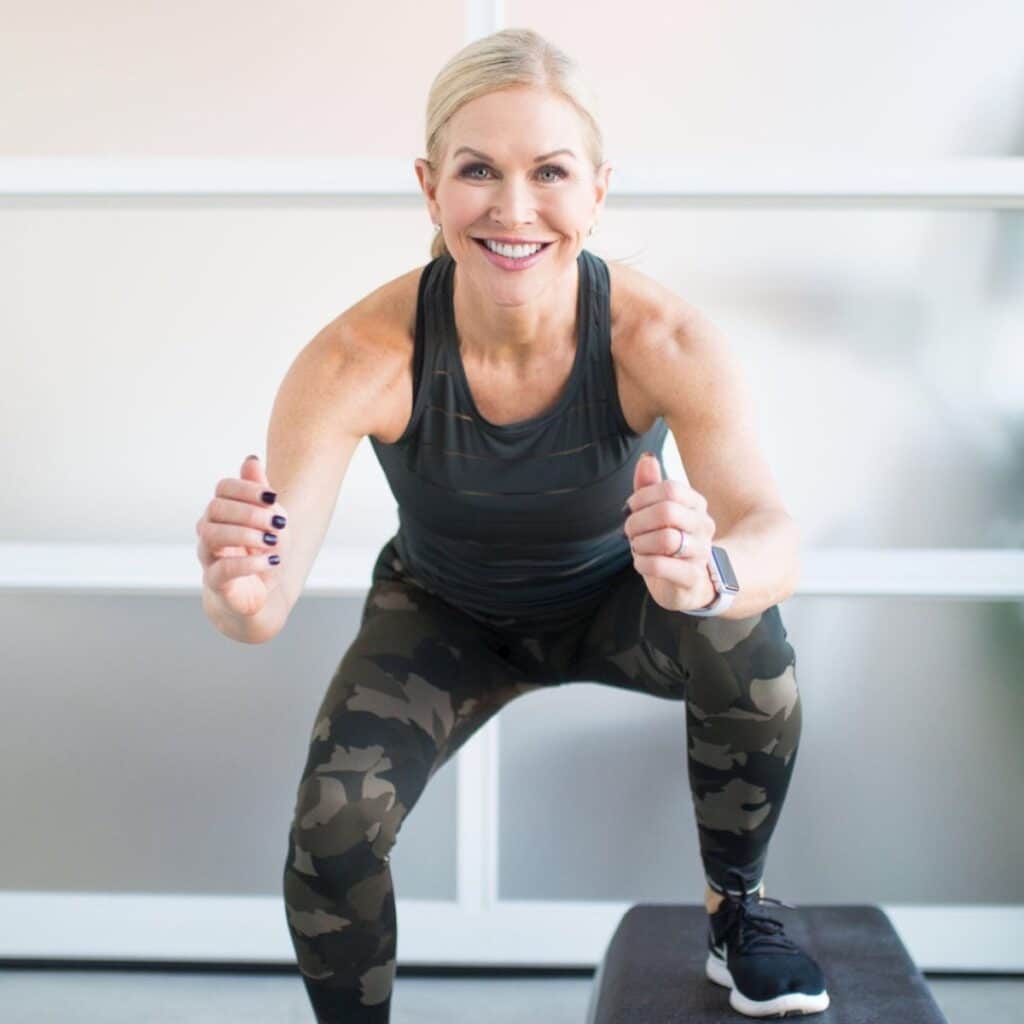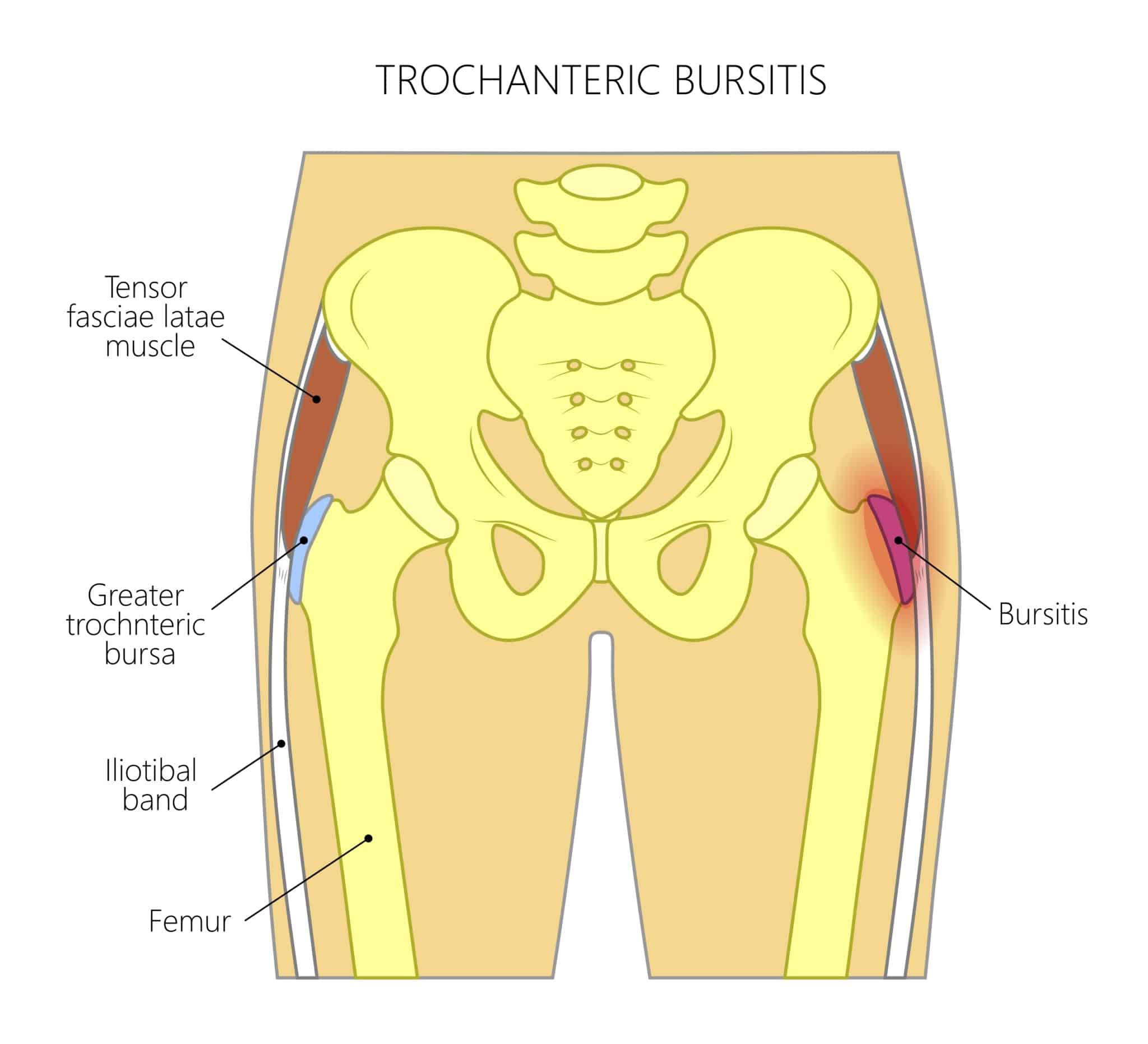This post contains affiliate links. Please see our disclosure policy.
Ease your hip pain with these 9 safe hip bursitis exercises. Find out the safest moves for hip bursitis pain, and which ones to skip for effective relief.
If you’ve been feeling persistent hip pain, especially when lying down or standing up, you might be grappling with hip bursitis.
It’s a condition that many, especially athletes and those over 50, experience as it results from inflammation in the bursa sacs located in the hip joint. These small, fluid-filled sacs are crucial for reducing friction between bones, tendons, and muscles. When they become inflamed, discomfort can range from mild to severe.
But here’s the good news—managing and even healing hip bursitis can be achievable through targeted exercise and rest.
This blog post will guide you through nine hip strengthening exercises specifically designed to ease hip bursitis, enhance mobility, and prevent future flare-ups.

Save This Article To Read Later
Table of Contents
- Understanding Hip Bursitis
- Benefits of Targeted Hip Bursitis Exercises
- The Best Hip Bursitis Exercises
- Glute Bridges
- Fire Hydrants
- Clam Shells
- Side Plank
- Iliotibial Band Stretch
- Hip Abduction (Side Lying Leg Lifts)
- Figure Four Stretch on Your Back
- Knee to Chest Stretch on Your Back
- Kneeling Hip Flexor Stretch
- Low Impact Cardio Exercise for Hip Bursitis
- Hip Bursitis Exercises to Avoid
- Common Symptoms of Hip Bursitis
- What Causes Hip Bursitis?
- The Importance of Exercise for Hip Bursitis
- Precautions and Modifications for Hip Bursitis Exercises
- A New Path to Pain-Free Living
- FAQ
Understanding Hip Bursitis
Before jumping into exercises, let’s discuss what hip bursitis is. This condition involves the inflammation of the bursae, which are small sacs filled with lubricating fluid that reduce friction and cushion pressure points between your bones, tendons, and muscles around your joints.
In the hip, this inflammation can cause significant discomfort.

Many factors can contribute to hip bursitis, including repetitive motions, prolonged pressure on the joint, or even poor posture (PS. Have you tried my posture exercises?!). For athletes, the condition often arises from overuse, while for menopausal women or those over 50, it can be due to decreased flexibility or muscle imbalances.
Knowing what causes bursitis can help with prevention. Awareness and mindfulness in daily activities can go a long way in preventing future occurrences of this condition.
Benefits of Targeted Hip Bursitis Exercises
Exercise is a powerful tool in the recovery and management of hip bursitis. By engaging in specific strengthening exercises, you can stabilize the hip joint, improve muscle balance, and reduce the friction that exacerbates bursitis.
These exercises mainly target the glute muscles, particularly those at the sides of the hips. Strengthening these muscles supports your legs during movement, thereby reducing stress on the bursae.
Additionally, regular exercise helps maintain flexibility and improves overall joint health, which is essential for anyone experiencing or looking to prevent hip bursitis. Remember, the key is consistency combined with adequate rest.
Try a few of these nine exercises to help give you some healing and relief.
The Best Hip Bursitis Exercises
Here are nine exercises you can do at home to treat your bursitis and work your whole body:
Workout Instructions:
- Follow the instructions on each exercise, focusing on your form and proper technique to avoid additional strain
- As you build strength, you can gradually increase the intensity and repetitions.
Glute Bridges
The glute bridge is a foundational exercise that strengthens the glutes, core, and lower back. Glute bridges are a gentle yet effective way to engage the muscles supporting the hip joint, crucial for anyone experiencing hip bursitis.

How to Perform Glute Bridges
- Starting Position: Lie on your back with knees bent and feet flat on the floor, hip-width apart. Arms should rest at your sides with palms facing down.
- Execution: Press through your heels to lift your hips off the ground while squeezing your glutes. Hold at the top for a count of two, ensuring a straight line from shoulders to knees.
- Return: Lower your hips back to the ground gently, maintaining control throughout the movement. Repeat for 10-15 reps.
The glute bridge is also a great option for seniors because it’s gentle, but powerful. I put together a handy guide to hip strengthening exercises for seniors that take age and ability into special consideration.
Fire Hydrants
The fire hydrant move targets the gluteus medius, essential for hip stability. This exercise is named after its resemblance to a dog lifting its leg by a fire hydrant. While it may seem funny, it effectively strengthens the muscles necessary for hip stability.

How to Perform Fire Hydrants
- Starting Position: Begin on all fours, with hands under shoulders and knees under hips.
- Execution: Keeping the knee bent, raise one leg out to the side until thigh is parallel to the ground. Your core should remain engaged.
- Return: Slowly lower the knee back to the starting position. Perform 10 reps on each side.
Clam Shells
Clamshells are perfect for targeting the hip abductors. This exercise is fantastic for strengthening the muscles that support your hips and help stabilize your gait when walking or running.

How to Perform Clam Shells
- Starting Position: Lie on your side with legs stacked, knees bent at 90 degrees.
- Execution: Keeping feet together, lift the top knee as high as possible without moving your pelvis. Hold the position briefly.
- Return: Lower the knee back to the starting position. Complete 10-12 reps per side.
Side Plank
The side plank move challenges your core and hip stability. They work your glute muscles to lift and stabilize your pelvis.

How to Perform Side Planks
- Starting Position: Lie on your side with your legs straight and stacked on top of each other. Rest your forearm on the floor, aligning your elbow under your shoulder.
- Execution: Engage your core and lift your hips and knees off the floor. Your body should be in a straight line from your head to your feet with only your forearm and bottom foot touching the floor. (Drop your bottom knee to the floor for a modification.)
- Return: Hold this position for 15-30 seconds. Then, slowly lower down to the starting position.Repeat on other side.
Iliotibial Band Stretch
Stretching the IT band helps alleviate tightness that can aggravate bursitis. Stretching the IT band can be especially beneficial if you tend to experience bursitis discomfort on the outer part of your hip.

How to Perform the Iliotibial Band Stretch
- Starting Position: Stand upright, cross your right leg behind your left.
- Execution: Lean to the left, pushing your right hip out until you feel a stretch along the outside of your right thigh.
- Return: Hold for 20-30 seconds before switching sides.
Hip Abduction (Side Lying Leg Lifts)
Similar to side lying leg raises, this variation focuses intensely on the hip abductors. This exercise is slightly modified to emphasize the outer hip and thigh muscles, crucial for those with bursitis.

How to Perform Hip Abductions (Side Lying Leg Lifts)
- Starting Position: Lie on your side with legs stacked.
- Execution: Lift the top leg upwards, keeping it straight and aligned with your body. Avoid tipping your pelvis.
- Return: Gently lower the leg back. Perform 12-15 reps per side.
Figure Four Stretch on Your Back
This stretch offers relief through deep hip opening. The figure four stretch not only aids in flexibility but also releases tension in the hip joint.

How to Perform the Figure Four Stretch on Your Back
- Starting Position: Lie on your back with knees bent.
- Execution: Cross one ankle over the opposite knee, forming a “4” shape.
- Return: Gently pull the uncrossed leg toward you until you feel a stretch in the crossed hip. Hold for 20-30 seconds.
Knee to Chest Stretch on Your Back
This stretch helps alleviate tension in the lower back and hips. This simple stretch enhances hip flexibility and helps relieve stress on the bursa.

How to Perform the Knee to Chest Stretch on Your Back
- Starting Position: Lie on your back with legs extended.
- Execution: Bring one knee towards your chest, holding it with both hands.
- Return: Hold for 20-30 seconds before switching legs.
Kneeling Hip Flexor Stretch
This stretch targets the front of the hip, often tight in those with bursitis. The kneeling hip flexor stretch helps loosen tight hip muscles and can reduce overall discomfort.

How to Perform the Kneeling Hip Flexor Stretch
- Starting Position: Kneel on one knee with the other foot in front, creating a 90-degree angle.
- Execution: Shift your weight forward slightly until you feel a stretch in the hip of the kneeling leg.
- Return: Hold for 30 seconds, then switch legs.
Low Impact Cardio Exercise for Hip Bursitis
If you suffer from hip bursitis, finding the right cardio exercise can be challenging. High-impact activities like running and jumping can cause additional pain, making it difficult to stick to a regular workout routine.
However, low-impact cardio exercises can provide a great alternative, offering numerous health benefits without putting excessive strain on the hip joint.
Here are some of the best low-impact cardio exercises for hip bursitis relief:
| Yoga | Try these yoga poses to relieve tight hips. Add them to your daily routine! |
| Walking | This is a personal favorite! Power walking is a great low-impact cardio exercise that is gentle on the joints and helps improve balance and coordination. You can even add a walking pad into your weekday routine to walk while you work. (I walk at 1 mph while I work on my computer.) |
| Swimming | While it’s not always easy to get to a pool, swimming is a fantastic form of low-impact aerobic exercise (and one of the best cardio workouts for weight loss) that provides a whole-body workout, strengthens muscles and joints, and enhances cardiovascular fitness. Follow this beginner’s guide to swimming to get started. |
| Cycling | Gaining in popularity, cycling on a stationary bike or outdoors on level terrain (low resistance) provides a low-impact workout that improves cardiovascular endurance and strengthens the leg muscles. |
| Elliptical Training | A workout classic. Elliptical machines simulate walking or running without the impact on the joints, and this exercise helps to build cardiorespiratory fitness and burn calories. Here are three elliptical workouts to get you started! |
| Water Exercise | In addition to swimming laps, other water exercises can be a great way to help relieve hip bursitis symptoms. The buoyancy of the water can help reduce joint stress and impact, creating a low-impact environment for exercise. Try my 30 minute pool workout for seniors. |
Low-impact cardio exercises are typically safe and joint-friendly, making them ideal for individuals with hip bursitis looking to stay active while minimizing pain and discomfort.
However, these movements are repetitive motions. I do recommend connecting with your healthcare professional or physical therapist to assess your situation and decide when beginning regular low impact exercise is recommended.
Hip Bursitis Exercises to Avoid
While exercise is essential for managing hip bursitis symptoms, it is equally important to avoid exercises that can aggravate the condition. High-impact exercises that put excessive stress on the hip joint should be avoided to prevent further injury and discomfort.
These are the most common exercises to avoid when suffering from chronic hip bursitis:
- Running. High-impact running exercise increases pressure on the hip joints.
- Plyometrics. Exercises that involve jumping put excessive pressure on the hip joints and aggravates inflammation.
- Lunges. Even though popular, lunges stress the hip joint and can be painful for those suffering from bursitis.
- Squats. Similar to lunges, deep squats put additional stress on the hips and can cause discomfort.
Avoiding these exercises will help prevent worsening of hip bursitis symptoms and promote healing.
Remember to consult your healthcare provider before starting any new exercise program.
Common Symptoms of Hip Bursitis
Symptoms of hip bursitis may include pain, swelling, and stiffness in the hip, as well as difficulty walking or bending the affected joint.
The symptoms of hip bursitis vary from person to person, but the most common are:
- Hip pain that is sharp at first and then becomes aching over time
- Hip tenderness which seems more generalized in the entire hip area
- Pain that gets worse after prolonged or repetitive activity
- Leg pain that extends from the hip down the side or back of the leg
- Pain or discomfort when climbing stairs, running or cycling
Important note: if you have warmth and redness in the area along with fever or illness, you could have septic bursitis which comes from infection. Be sure to see your doctor!
What Causes Hip Bursitis?
There are a number of things that can cause bursitis of the hips, from a direct fall to running too many miles. Let’s take a look at some of those things that put you at risk.
Here are some of the most common causes of hip bursitis:
| Menopause | When estrogen starts to decline, joint pain can surface. Estrogen is an anti-inflammatory and protector of joints. |
| Repetitive Motion | Common repetitive motions like cycling, running, climbing or lots of squats, could cause hip bursitis to flare up. Be very cautious when doing any activity that causes increased load on your joints and is high in repetition. |
| Leg-Length Inequality | Believe it or not, a surprising number of people have one leg that is slightly shorter than another (1.5 cm or more). This can affect your gait, causing issues similar to the repetitive use problem resulting in bursitis. |
| Arthritis | Bursitis can come from arthritis. The same inflammation that comes with arthritis can extend into the bursa. |
| Spine Diseases | Conditions like scoliosis can cause problems with the movement pattern of your hips and play a role in bursitis. |
| Prior Surgery | Like spine diseases, prior surgeries such as implants or hip replacements can throw off your gait and movement patterns, creating inflammation. |
The Importance of Exercise for Hip Bursitis
Regular strength training exercises can provide multiple benefits to those suffering from hip bursitis. One of the most significant advantages is relief from pain and stiffness.
Hip bursitis often resolves with targeted exercises and rest from aggravating activities. Exercises for hip bursitis will include movements that strengthen the hip and improve mobility of the joint.
I always say “motion is lotion.“
When you move, synovial fluid helps to cushion and lubricate the joint. (Synovial fluid is a thick liquid located between the joints).
When performed correctly, exercises for hip bursitis can also lead to improved posture and a reduction in the incidence of further injury or strain. Additionally, physical activity stimulates blood flow, which can promote healing and reduce inflammation.
It is essential to note that exercise should be performed with caution to prevent further damage to the affected area. Always consult a healthcare professional before starting a new exercise routine, especially if experiencing chronic pain.
Precautions and Modifications for Hip Bursitis Exercises
When performing hip bursitis exercises, it’s essential to take proper precautions to avoid further injury and ensure safe and effective workouts.
Here are some exercise modifications and safety tips to consider:
| Start Slow | If you’re new to exercise or haven’t worked out in a while, start slow and gradually increase the intensity and duration of your workouts. This approach will help you avoid overexertion and reduce the risk of injury. |
| Avoid High-Impact Exercises | High-impact exercises like running, jumping, and plyometrics can aggravate hip bursitis symptoms and cause further inflammation. Instead, opt for low-impact exercises like swimming, cycling, and walking to reduce joint stress. |
| Listen to Your Body | Pay attention to your body’s signals and adjust your workout intensity accordingly. If you experience pain or discomfort during an exercise, stop immediately and rest. Resume the exercise only if the pain subsides. |
| Use Proper Form | Using proper form is crucial while performing hip bursitis exercises. Incorrect form can put additional strain on the hip joint and cause further injury. Ensure that you maintain proper posture, engage the correct muscles, and take slow, controlled movements while performing each exercise. |
| Avoid Overstretching | While stretching is essential for relieving tension and increasing flexibility, overstretching can cause muscle strain and aggravate hip bursitis. These are my favorite hip opening stretches to relieve your hips. I recommend avoiding deep, intense stretches and opt for gentle, controlled movements. |
With these precautions and modifications, you can perform hip bursitis exercises safely and effectively.
A New Path to Pain-Free Living
While living with hip bursitis can be challenging, incorporating these exercises into your routine can lead to significant improvements. Each exercise is designed to strengthen the muscles surrounding the hip, reduce stress on the bursae, and promote healing.
Whether you’re an athlete, a physical therapy patient, or someone passionate about fitness, these exercises offer a proactive way to manage hip bursitis and enhance your overall quality of life.
Remember, consistency is key, and it’s important to listen to your body. If you experience any pain while performing these exercises, consult with a healthcare professional to ensure you’re on the right track.
Stay empowered and take charge of your health with dedication and mindfulness. Here’s to a pain-free, active life!
FAQ
In addition to exercise, other treatments for hip bursitis may include physical therapy, pain management techniques like ice or heat therapy, and anti-inflammatory medications. If symptoms persist or worsen, it is advisable to consult a healthcare professional for further evaluation and treatment.



Get rid of dairy and sugar, solved my hip problems.
Is there any equipment I can use for hip bursitis as I hate doing ordinary exercise. I know this sounds stupid but I would sooner use something.
Unfortunately I am not sure of any equipment that is going to help you strength your hips with hip bursitis. There is definitely equipment that will protect your hip, a heating pad, and also foam rollers that are pieces that you can use to help with exercises. But you are going to have to do the stretching and training on your own for this one.
I will do some more research, but most exercises you can do for hip bursitis include your own body and exercises to do on your own.
I have been suffering from hip pain for as long as I can remember. I did have a complete spinal fusion with Herrington rods inserted due to Scheuermann’s Disease at 15 yrs old. I did not experience any pain until I had my third child. After that, the pain symptoms started in different areas and pain gradually became worse. I do not know if it has been a contributing factor to the bursitis and all of the arthritis that has set up in different joints in my body. I found one simple solution that has AT THE LEAST given me opportunity to actually sleep and it’sa small curved knee pillow, or ( foam ). I saw it on TV and they sell them at different places but I found mine at Dollar General for about $10-$15. It’s been the thing I’ve ever bought from this store! I urge you to try it. It is small and it is grooved to fit right between your knees without it feeling s awkward when you sleep. I hope you can find some relief however you do !
I’ve had hip bursitis for nearly 15 years, and the left one is very painful at night no matter what exercises I perform. I occasionally get relief from lavender oil. Had cortisone injections, but they were unsuccessful. I’ve started seeing an osteopath in the hopes that he can assist me. Please offer any further recommendations. I work a sedentary job where I spend most of my time sitting down.
Wow – sounds like you have tried a lot of different remedies for your hip bursitis. Does your hip feel better the more movement you get in the body or does that hurt it? Curious if more “low impact” movement helps or makes things worse.
I think if I lost weight my newly diagnosed bursitis in my hip would In prove.
I’m limited in movement. Also how soon can I try the stretching exercises seen here. I’m taking anti inflammatory medicine right now. Pain is about a 6 from a scale from 1- 10.
Any suggestions?
Thank you
Well yes – weight loss would help to alleviate stress to your hips. In regards to when you can start stretching, check with your doctor but movement is going to help reduce the pain. I always say “motion is lotion” – it’s worse to just sit still – moving will help to provide lubrication. In the case of bursitis – you need approval from the doctor -but if you can tolerate it – I would try. Also I don’t know how old you are – declining estrogen can be a cause of joint pain and hip bursitis… but again – you need a doctor to help with that!
I have had intermittent minor hip pain for 35 yrs. or more and only recently did it get bad enough to check out. Xrays showed I have a bone spur on the outside of my hip, that irritates the bursa… I am 71 and in last 2 yrs. have been going to the gym 3 times a week and spending 30 min. on weight machines and walk 1 mile on treadmill — and that seldom bothers my hip. However, getting comfortable to get to sleep & stay asleep is my BIG problem. Rehab said more strengthening is really only solution and directed me to do 4 of above exercises… which I have been doing…with little effect. My question…I have a hydraulic rowing machine that was recommended in one of your articles…would that be GOOD or BAD to help strengthen and stretch the hip???
Wel – the rowing could be good under the premise of strengthening and lubricating. BUT – listen to your body and if you feel any pain – always back off. ALSO _ in terms of comfort – are you sleeping on that side? YOu may want to try different body pillows that can position your leg/hip to reduce aching? Just a thought!!
Great read! The exercises for hip bursitis are clearly explained, and the tips are practical and easy to follow. It’s a helpful guide for anyone dealing with hip discomfort. Thanks for sharing.
Thanks for sharing these exercises! I’ve been struggling with hip bursitis for a while, and I appreciate the detailed explanations. I’m excited to try these out and hopefully find some relief.
I hope they help!!